Your Fave?
Which of today’s five featured images do you like best? All are invited to leave a comment and let us know why they made their choice.
What’s Up
Saturday morning at the East Pond was very good, but with large groups of birders visiting on the weekend along with a few photographers, photography was not as good as it had been on the previous morning. With lots of birders around you do not have as much freedom to approach the completely tame birds as you do when there is nobody else around. Most of the birders that we ran into had no problem flushing the birds that we had approached so closely and carefully by butt crawling. Speaking gently, without getting pissed off at all, I suggested several things that they could do to minimize the disturbance of the birds as they made their way up the eastern shoreline. The response? “I’ve been doing this for 25 years.” They went on, 100% ignored my suggestions (stay close to the reeds and hold your tripods — they all had spotting scopes — in front front of you rather than on your shoulder), and flushed all the birds when they came upon to the next photographer …
Today is Sunday 22 August and the forecast is for rain all day long. Wherever you are, and whatever you are doing, I hope that you too have a great day.
Please note that it is best to click on each blog image to view it larger. For unknown reasons, the images — even the verticals that are not rendered larger, look sharper once they’ve been clicked on.
Remember that you can find some great photo accessories (and necessities!) on Amazon by clicking on the Stuff tab on the orange/yellow menu bar above. On a related note, it would be extremely helpful if blog-folks like me, who spend too much money on Amazon, would get in the habit of clicking on the Amazon logo link on the right side of each blog post when they shop online. As you might expect, doing so will not cost you a single penny, but would be appreciated tremendously by yours truly. And doing so works seamlessly with your Amazon Prime account.
This blog post took about two hours to prepare and makes 235 consecutive days with a new one. Please remember that if an item — a Delkin flash card, or a tripod head — for example, that is available from B&H and/or Bedfords, is also available in the BAA Online Store, it would be great, and greatly appreciated, if you would opt to purchase from us. We will match any price. Please remember also to use my B&H affiliate links or to save 3% at Bedfords by using the BIRDSASART discount code at checkout. Doing either often earns you free guides and/or discounts. And doing so always earns my great appreciation.
|
|
The Saturday morning In-the-Field group at JBWR in AugustFrom left to right, Brenda Gates and IPT veterans Dianne Heggie and Anke Frohlich. |
Impromptu Trash Bag Butt Mud-Guards
The ladies all sported impromptu trash bag butt mud-guards. Yours truly opted to sit in the mud with quick-drying slacks and quickly wound up with a wet butt. The ladies stayed clean and dry.
Recipe
One box of heavy duty trash bags (compactor bags would be better).
On roll of paper tape.
One pair of scissors.
Some ingenuity.
|
|
The iPhone Photography e-Guide
|
Hard to Believe
Yes, Cliff has a great eye and wonderfully creative vision. Yet it is still hard for me to believe that he can make so many great images with “just“ an i-phone. Almost more amazingly Cliff captures with his iPhone and does all of his post-processing on the phone! In this great new e-Guide written for BIRDS AS ART you will learn to use set up you iPhone quickly and efficiently and how to use it. In addition, there are dozens and dozens of tips on Cliff’s favorite apps and his favorite gear. Scroll down to the bottom to see the Table of Contents.
The iPhone Photography e-Guide: $20.00.
To order your copy of the iPhone Photography e-Guide please click here.
Dr. Cliff Oliver
Dr. Cliff Oliver is an award-winning photographer, former photography instructor for the San Diego Natural History Museum, cutting-edge integrative health care professional, and international workshop leader. He created and taught the first 5-day immersion iPhone photography workshop at Hollyhock, Canada’s premier Leadership Learning Center. He teaches quarterly iPhone photography classes at the Athenaeum Music & Arts Library School of the Arts (these include Art on the iPhone, iPhoneography, Portraits and Selfies, and Practicing in the Field). His images have been on the cover of WildBird magazine, on display at Scripps Oceanography Institute, and been honored with multiple first-place finishes in the International Exhibition of Photography Del Mar. The San Diego Natural History Museum’s, “Birds of the World” centennial exhibit featured several of his images. One of his iPhone images received an honorable mention in the Athenaeum 23rd annual juried exhibition. He has displayed images at Art Speaks: Expressions of Hope and Healing and has produced a series of books, called Zen I, II, III, IV, V, VI and VII that feature original images that promote inner peace. The last 4 books feature only images taken on the iPhone. He teaches individuals and groups the skills of capturing iPhone/mobile photographs and then how to create personalized works of art.
To see some of Cliff’s iPhone images, click here. Learn more about Cliff and what he does on his Center for Balance website here. And don’t forget, if I had never met Cliff I would be pushing up daisies somewhere. To request my Health Basics File that contains the whole story, please shoot me an e-mail by clicking here..
|
|
|
This image was created on 21 August 2021 at the East Pond, Jamaica Bay Wildlife Refuge, Queens, NY. While standing at full height, I used the and held Sony FE 600mm f/4 GM OSS lens and The One, the Sony Alpha 1 Mirrorless digital camera. ISO 800. Exposure determined via Zebras with ISO on the rear dial: 1/5000 sec. at f/4 (wide open) on a then mostly sunny morning. Tracking: Spot S/AF-C was active at the moment of exposure and performed beyond perfectly. Be sure to click on the image to enjoy the larger version. Image 1: Lesser Yellowlegs, juvenile on rotting board |
Almost Famous …
I spotted this young LEYE standing peacefully on an old rotted plank — a remnant of the former baymen’s community know as the Raunt (circa the 1940s & 50s), got into position square to the old board, and made some images. At one point, the lens got too heavy to hold in place while standing so I owe it. The bird executed the most lovely near-wing stretch with its head turned slightly toward me. I missed it 🙁
|
|
|
This image was created on 20 August 2021 at the East Pond, JBWR, Queens, NY. While seated on wet mud, working off the a1’s tilted rear screen on the splayed Induro GIT 304L topped by a Levered-Clamp FlexShooter Pro– with the Sony FE 600mm f/4 GM OSS lens with the Sony FE 1.4x Teleconverter(at 840mm) and The One, the Sony Alpha 1 Mirrorless digital camera. ISO 1250. Exposure determined via Zebras with ISO on the Thumb Wheel: RawDigger showed that the raw file brightness was dead solid perfect: 1/1250 sec. at f/6.3 (stopped down 1/3 stop) in Manual mode. AWB at 11:00am on a then cloudy morning. Tracking: Spot S/AF-C with Bird-Eye/Face Detection performed perfectly by tracking and nailing the bird’s eye. Image #2: Short-billed Dowitcher stretching |
Dull Day Processing
On a mostly dingy day, the properly exposed raw files were dull and washed out. After setting the white and black points, I increased the contrast just a bit, I boosted the Vibrance to an unprecedented 85. Did I overdo it?
|
|
|
This image was created on 21 August 2021 at the East Pond, JBWR, Queens, NY. While seated on wet mud, working off a lowered Induro GIT 304L topped by a Levered-Clamp FlexShooter Pro– with the Sony FE 600mm f/4 GM OSS lens with the Sony FE 1.4x Teleconverter(at 840mm) and The One, the Sony Alpha 1 Mirrorless digital camera. ISO 1600. Exposure determined via Zebras with ISO on the Thumb Wheel: RawDigger showed that the raw file brightness was dead solid perfect: 1/1600 sec. at f/6.3 (stopped down 1/3 stop) in Manual mode. AWB at 11:06am on a then cloudy morning. Tracking: Spot S/AF-C with Bird-Eye/Face Detection performed perfectly by tracking and nailing the bird’s eye. Image #3: Wilson’s Phalarope, molting juvenile and molting adult foraging |
East Pond Phalaropes
There were as many as three Wilson’s and three Red-necked Phalaropes on the pond in early August. We were thrilled on Friday morning to find and photograph one molting adult juvenile Wilson and a molting juvenile. We found them again on Saturday. They were both utterly tame. Here, I rather like the juxtaposition of the sharp juvie and the out-of-focus adult.
|
|
|
This image was created on 21 August 2021 at the East Pond, JBWR, Queens, NY. While seated on wet mud, working off a lowered Induro GIT 304L topped by a Levered-Clamp FlexShooter Pro– with the Sony FE 600mm f/4 GM OSS lens with the Sony FE 1.4x Teleconverter(at 840mm) and The One, the Sony Alpha 1 Mirrorless digital camera. ISO 1600. Exposure determined via Zebras with ISO on the Thumb Wheel: RawDigger showed that the raw file brightness was dead solid perfect: 1/1600 sec. at f/6.3 (stopped down 1/3 stop) in Manual mode. AWB at 11:16am on a then cloudy morning. Tracking: Spot S/AF-C with Bird-Eye/Face Detection performed perfectly by tracking and nailing the bird’s eye. Image #4: Wilson’s Phalarope, molting adult foraging |
Molting Adult Wilson’s Phalarope
The six or eight grey feathers covering the folded wing show that this is an adult birds molting into winter (basic) plumage. The juvenile shown in Image #3 is has only three new, gray feathers coming in as it molts to first-winter.
Typos
With all blog posts, feel free to e-mail or to leave a comment regarding any typos or errors.

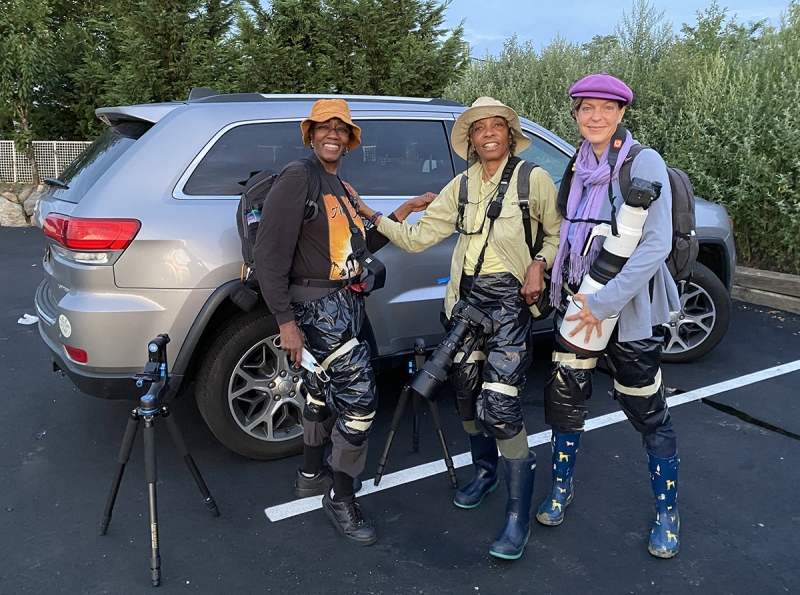
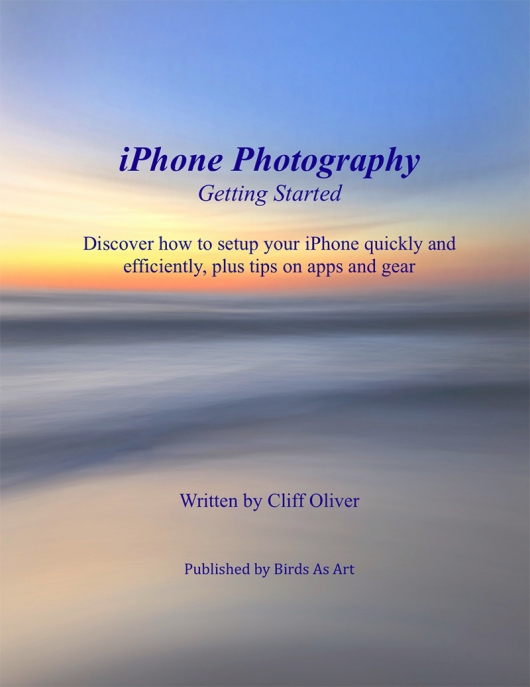
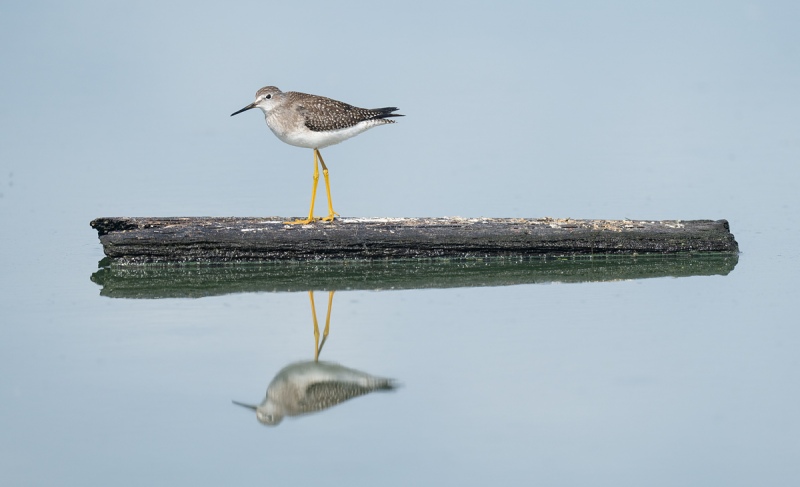
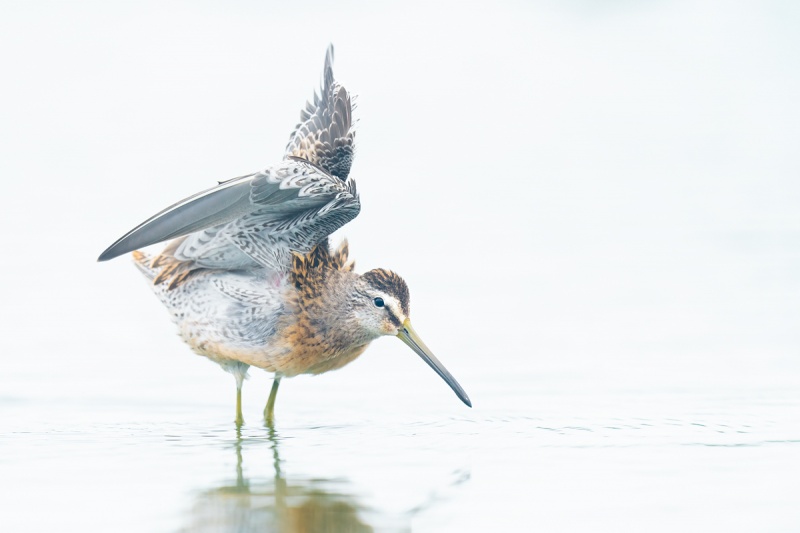
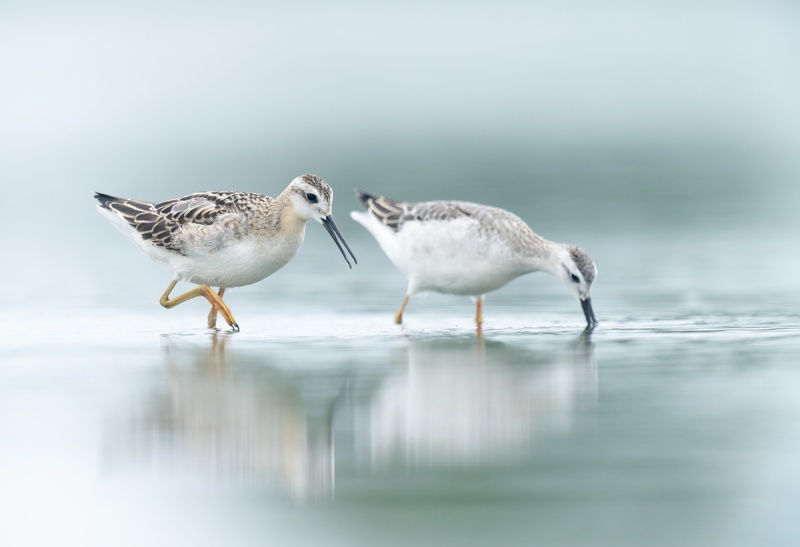
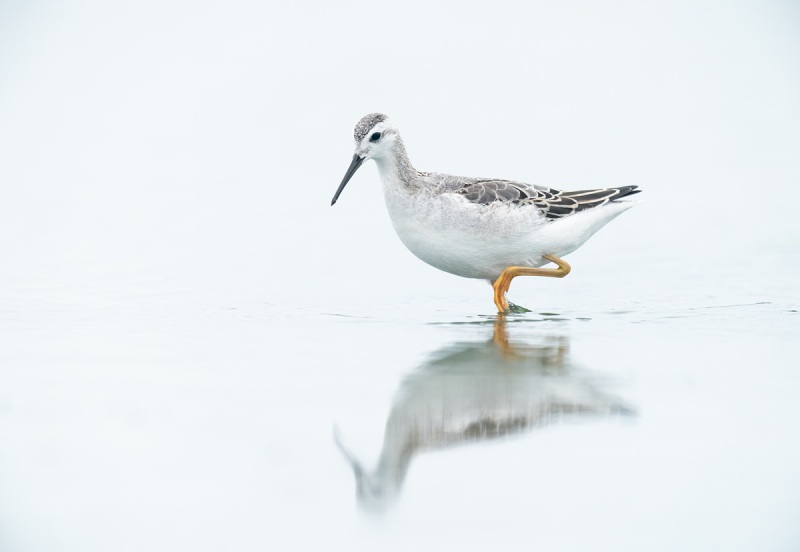













Image #1 for me. Love the composition!
Interesting episode with the “birders” and it is unfortunately, something I encounter too frequently in the field where there are other non-photographers. They seemingly have no problem walking right up and scaring the critters after I have carefully approached the subjects. Lovely images and I particularly like the ones with the blue-gray backgrounds.
I forgot the best part. The leader of one group actually said, “I was not as careful as I could have been.”
with love, artie
Juxtaposed Phalaropes for me. Beautiful composition. Only an occasional visitor in Australia and never got close. One day!
These are all beautiful! My favorite is the first one, Lesser Yellow Legs juvenile. Love the bird’s eye contact, the reflection, and the wonderful textures in the board it’s standing on.
My favorite is the Dowitcher. The color in the bird looks fine, but I’d prefer gray-day water rather than white, so maybe cut the Whites and/or Highlights? I like the look of the water in the first Phalarope image, made only six minutes later (understanding it’s not the same water). There are plenty of great white-on-white images, like your brightest Gannet closeups, but I think this one would look better darker.
I love #3 — beautiful, soft background and foreground with both an adult and an immature phalarope.
Ah yes, a refrain of which I am all too familiar, “pure” birders always know best. That out of the way, I really enjoy the foraging phalaropes image. Love the subtle color palette and it’s a treat to see two generations in the same image.
Beautiful photos! Love the lighting and reflections. Still have fond memories of the trash bag butt covers at JBWR…Hope for no problems there with Henri.